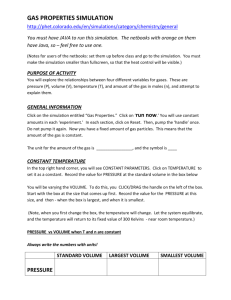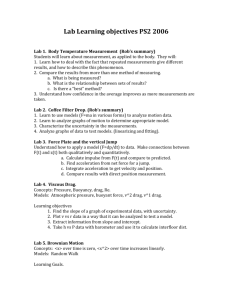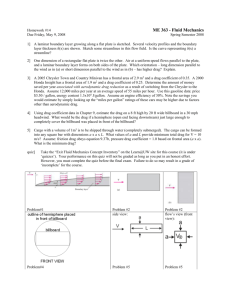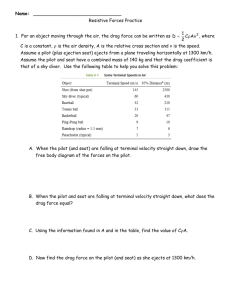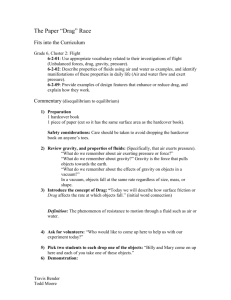ch9bHWans
advertisement
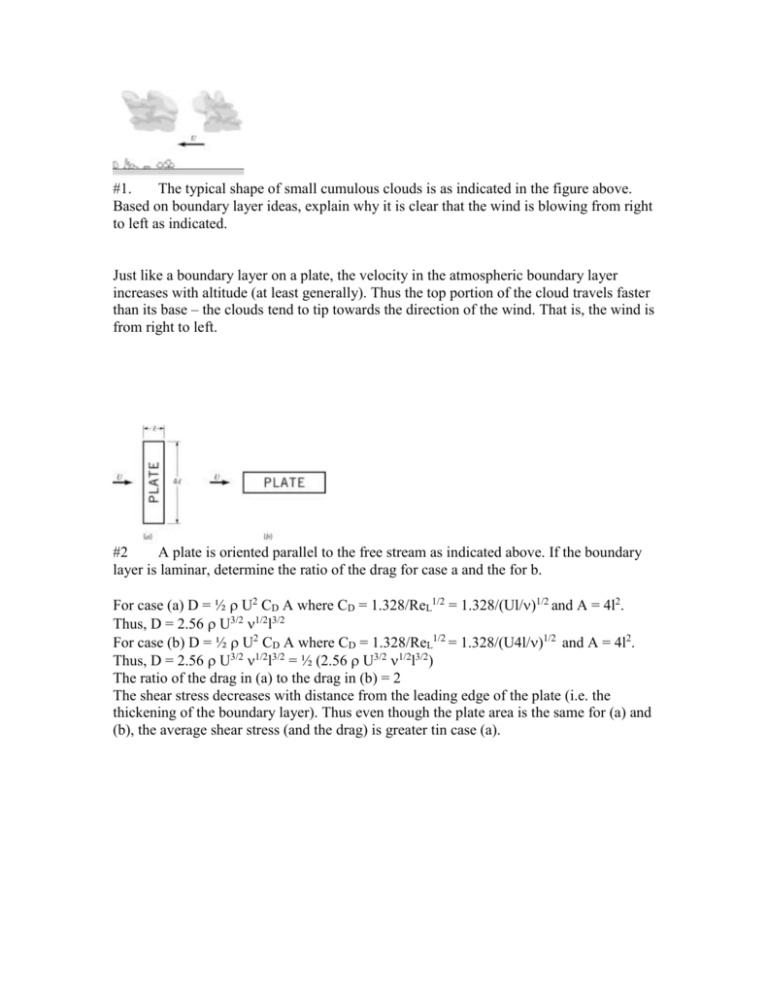
#1. The typical shape of small cumulous clouds is as indicated in the figure above. Based on boundary layer ideas, explain why it is clear that the wind is blowing from right to left as indicated. Just like a boundary layer on a plate, the velocity in the atmospheric boundary layer increases with altitude (at least generally). Thus the top portion of the cloud travels faster than its base – the clouds tend to tip towards the direction of the wind. That is, the wind is from right to left. #2 A plate is oriented parallel to the free stream as indicated above. If the boundary layer is laminar, determine the ratio of the drag for case a and the for b. For case (a) D = ½ U2 CD A where CD = 1.328/ReL1/2 = 1.328/(Ul/)1/2 and A = 4l2. Thus, D = 2.56 U3/2 1/2l3/2 For case (b) D = ½ U2 CD A where CD = 1.328/ReL1/2 = 1.328/(U4l/)1/2 and A = 4l2. Thus, D = 2.56 U3/2 1/2l3/2 = ½ (2.56 U3/2 1/2l3/2) The ratio of the drag in (a) to the drag in (b) = 2 The shear stress decreases with distance from the leading edge of the plate (i.e. the thickening of the boundary layer). Thus even though the plate area is the same for (a) and (b), the average shear stress (and the drag) is greater tin case (a). #3 If the drag on one side of a flat plate parallel to the upstream flow is D when the upstream velocity is U, what will be the drag when the upstream velocity is 2U; or U/2? Assume laminar flow. For laminar flow D = ½ U2 CD A, where CD = 1.328/ReL1/2 Thus D = ½ U2 1.328 ()1/2/(UL)1/2 A = 0.664 A [()1/2/(L)1/2] U3/2 Hence, DU/D2U = U3/2/(2U)3/2 so D2U = 2.83 DU Hence, DU/DU/2 = U3/2/(0.5U)3/2 so DU/2 = 0.354 DU #4 How much more power is required to peddle a bicycle at 15 mph into a 20-mph headwind (a) than at 15 mph through still air (b)? Assume a frontal area of 3.9 ft2 and a drag coefficient of CD 0f 0.88 P = power = UBD =and D = CD ½ U2 A, where UB = speed of the bike = 15mph[(88ft/s)/60mph) = 22 ft/s and U is wind speed relative to bike. Thus, P = (22 ft/s) (0.88) (1/2) (0.00238 slug/ft3) UB 2 (3.9 ft2) = 0.0898 U2 ft-lb/s with U in ft/s (a) With a 20 mph headwind, U = (15 + 20)mph [(88ft/s)/60mph)] = 51.3 ft/s Thus P(a) = 0.0898 (51.3)2 = 236 ft-lb/s (b) With still air, UB = 15 mph = 22 ft/sThus P(b) = 0.0898 (22)2 = 43.5 ft-lg/s Hence, need an additional power of P(a) – P(b) = (236-43.5) [ft-lb/s] (1 hp/550 ft-lb/s) =0.350 hp ______________________________________________________________________ #5 It is suggested that the power, P, needed to overcome the aerodynamic drag on a vehicle traveling at a speed U varies as P ~ Un. What is an appropriate value for the constant n? Explain your reasoning. P = UD = U CD ½ U2 A where for many vehicles the drag coefficient is essentially independent of Re number. Thus, CD is not a function of U so that P = CD ½ U3 A ----------------------------------------------------------------------------------------------------------- #6 A 0.30-m-diameter cork ball (specific gravity, SG = 0.21) is tied via a long string to an object on the bottom of a river. The current in the river, U, causes the ball to assume a 30o angle with the river bottom. What is the current speed, U. For the ball to remain stationary Fx = 0 and Fy = 0. Thus D = T cos 30o or T = D/cos 30o Hence, FB = W + Tsin 30o, where FB = gVol = (9.80 kN/m3)(4/3)(0.3/2 m)3 = 0.1385 kN and W = SG FB = 0.21 (0.1385 kN) = 0.0291 kN Thus balancing forces in the y-direction: 0.1385 kN = 0.0291 kN + D tan30o Or D = 0.189 kN, where D = CD ½ U2A = CD U2 (1/2) (999 kg/m3) ((0.3m)2/4) = 35.3CDU2N, where U ~ m/s Hence (eq. 1) 35.3 CDU2 = 189 (in N) or CDU2 = 5.35 (eq. 2)Also, Re = UD/ = 0.3m U/ 1.12x10-6m2/s =2.68 x 105 U Strategy for determining U: Trial and error for U: assume CD, calculate U from Eq. (1) and Re from Eq. (2); check CD from Fig. 9.11, iterate until CD’s converge . Assume CD = 0.5 then from Eq. (1) U = 3.27 m/s and Re = 8.76 x 105, and from Fig below CD = 0.15 which does not equal 0.5 so try again Assume CD = 0.15 then from Eq. (1) U = 5.97 m/s and Re = 1.6 x 106, and from Fig. below CD = 0.20 which does no equal 0.5 so try again Assume CD = 0.19 then from Eq. (1) U = 5.31 m/s and Re = 1.42 x 106, and from Fig. below CD = 0.19 so U = 5.31 m/s -----------------------------------------------------------------------------------------------------------#7 The United Nations Building in New York is a rectangle approximately 87.5 m wide and 154 m tall. Determine the drag on this building if the drag coefficient is 1.3 and the wind speed is 20 m/s. D = CD ½ U2 A = 1.3 (1/2) (1.23 kg/m3) (20 m/s)2 (154m)(87.5m) = 4.31 x 106 N -----------------------------------------------------------------------------------------------------------#8 Repeat this problem (#7) if the velocity profile against the building is a typical profile for an urban area (u = Cy0.4) and the wind speed half way up the building is 20 m/s. For an urban area u = Cy0.4. Thus with u = 20 m/s at y = h/2 = 77m we obtain C = 20/(770.4) = 3.52 or u = 3.52y0/4 with u ~ m/s and y ~ m The total drag is D = dD = CD ½ u2 dA = ½ CD 0154 (3.52 y0.4)2(87.5)dy D = (1/2)(1.23)(1.3)(3.52)2(87.5) 0154y0.8dy =4.17 x 106N #9 from book (Fox et al) prob 9.78; #10 from book (Fox et al) prob 9.101





